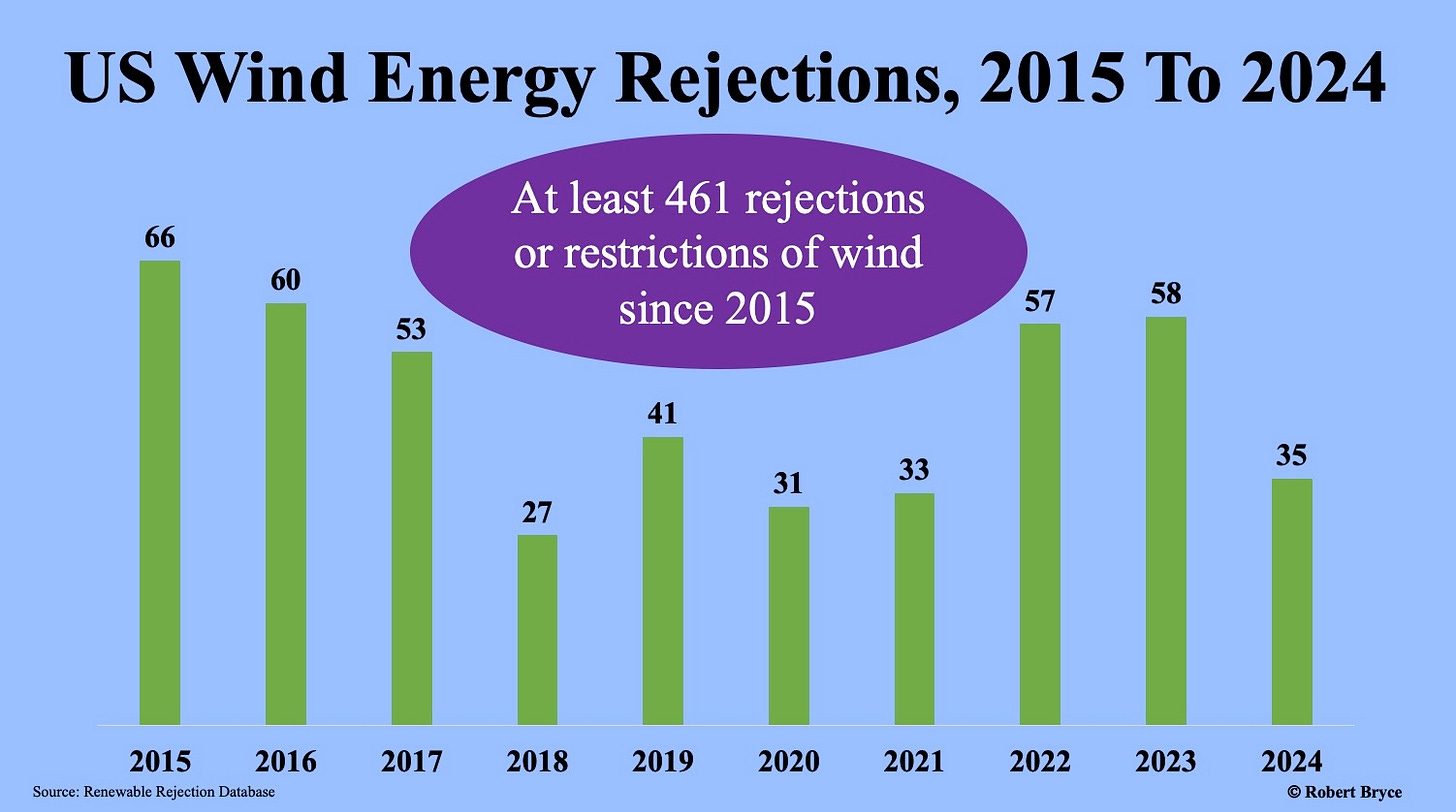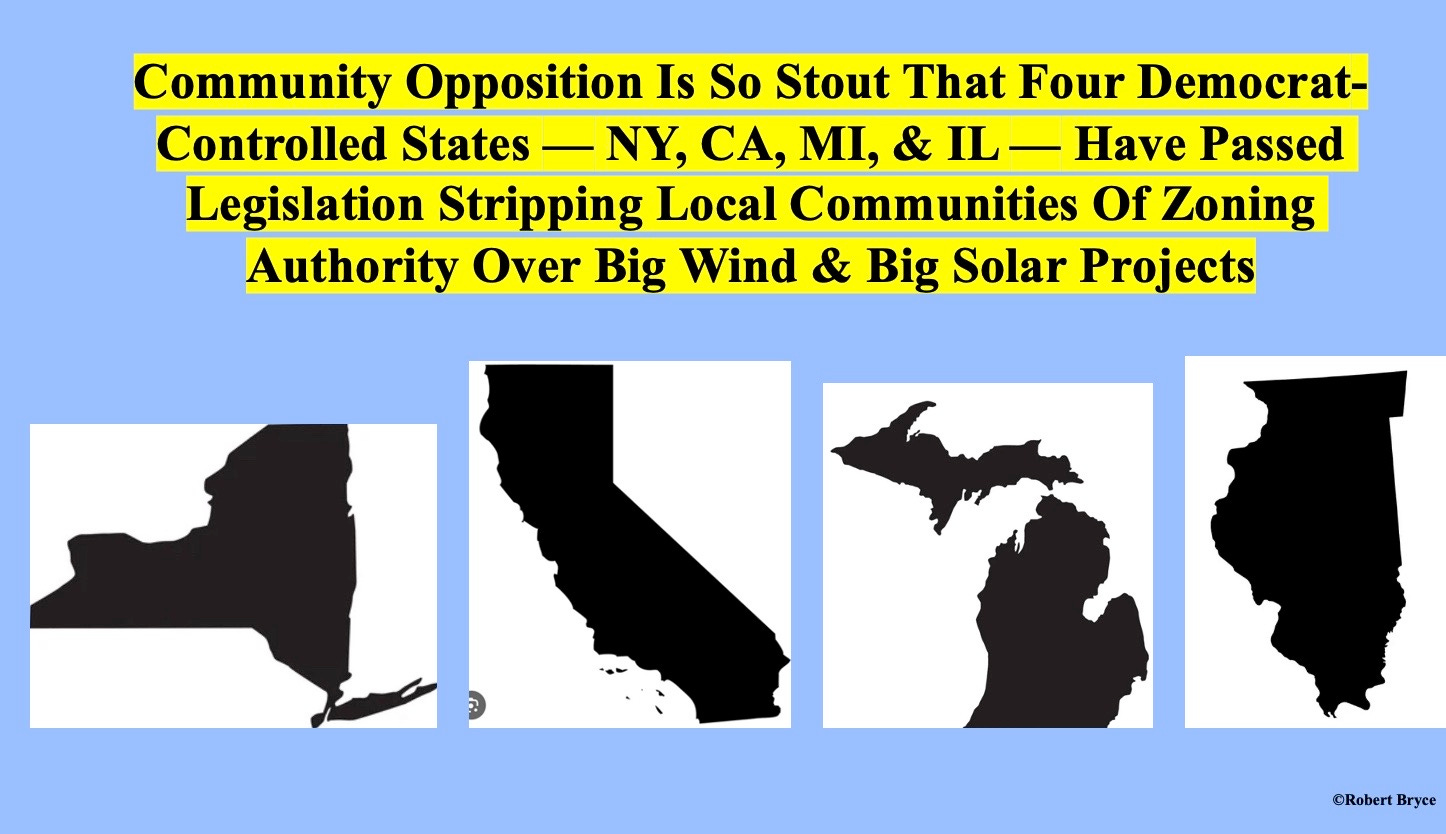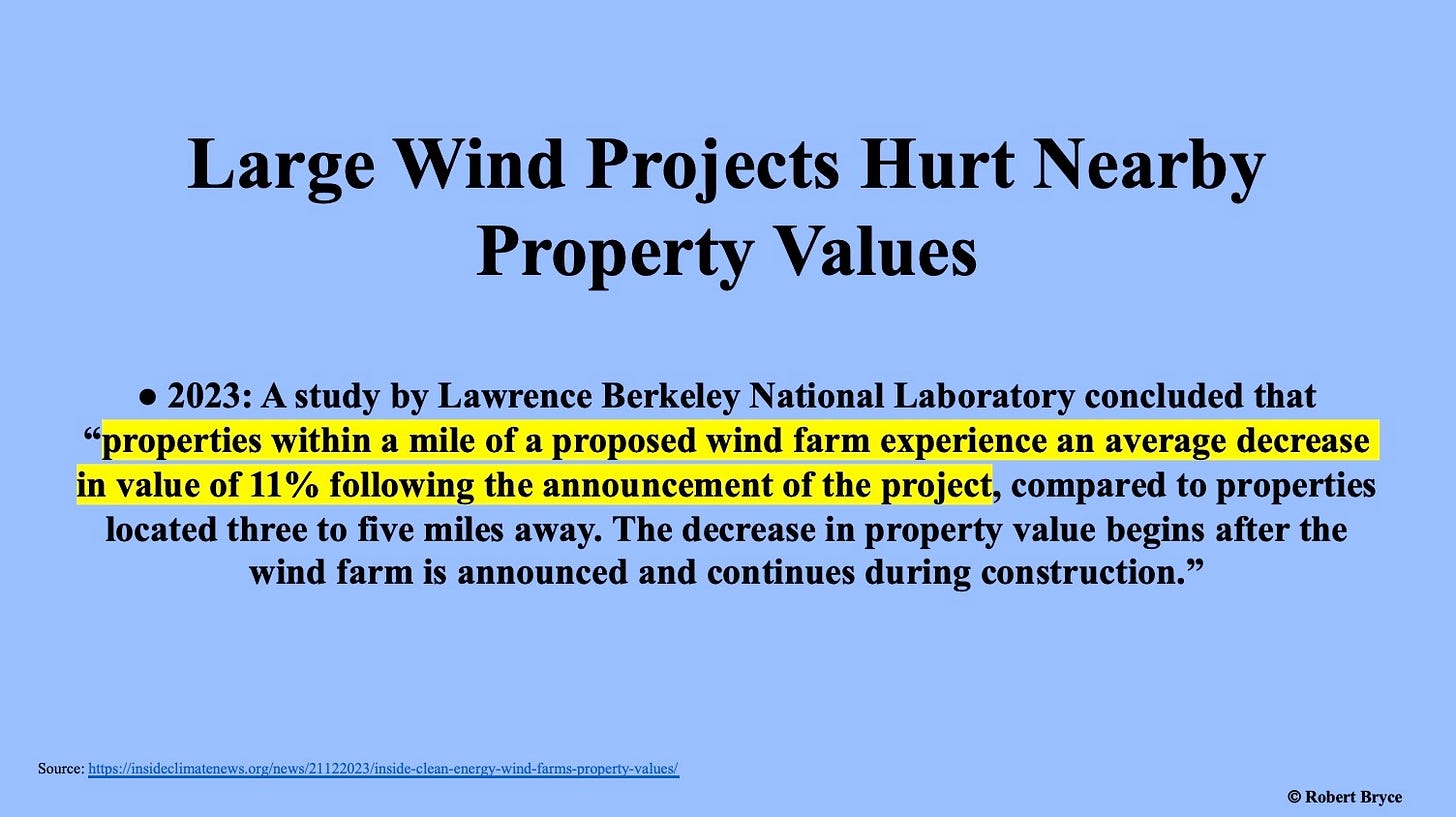Tally Of US Wind & Solar Rejections Hits 735
What the media, and academics, won’t tell you about the raging backlash in rural America against Big Wind and Big Solar, in 10 charts

You won’t read much about this in major media outlets, but nearly every week, local communities across the US are rejecting or restricting solar and wind projects. The latest rejection occurred a few days ago in Center, Nebraska, when the Knox County Board of Supervisors voted 6 to 1 to deny a conditional-use permit for a proposed solar project. According to an article by Mark Mahoney of the Yankton Daily Press & Dakotan, the board’s decision “drew applause from most of a nearly full courtroom at the county courthouse.”
The denial of the project in Knox County marks the 58th rejection or restriction of solar energy in the US this year. In addition, as can be seen in the Renewable Rejection Database, which I have just updated, there have also been 35 rejections of wind energy. Thus, since 2015, there have been 735 rejections or restrictions of wind and solar energy in the US.
To be clear, outlets like the New York Times, Washington Post, and National Public Radio have published a handful of articles in recent years about land-use conflicts over alt-energy in rural America. And to its credit, the Times has covered some of the conflicts in upstate New York. But that coverage routinely ignores the scale and frequency of the rejections and the conflicts. These rejections don’t fit the narrative that’s promoted by climate activists, academics at elite universities, and their myriad allies in the media about “clean,” “green,” and “renewable” energy. The Times has not written a single article about the longest-running legal battle over wind energy in American history: the Osage Nation’s 13-year legal fight with Enel. Last December, a federal court judge in Tulsa determined that the Italian company violated the tribe’s sovereignty when it built a 150-megawatt wind project in Osage County without getting permission to mine the tribe’s mineral estate. For more on that case, see my December 23, 2023, article.
Although big media outlets seldom cover these conflicts, the facts — and the numbers — are undeniable. Rural landowners and homeowners from Maine to Hawaii are fighting to protect the integrity of their neighborhoods. They don’t want their landscapes and viewsheds destroyed by oceans of solar panels and forests of 600-foot-high wind turbines. They are also rightly concerned about the diminution of their property values and the noise pollution that comes with these projects.
Furthermore, the latest rejections of wind and solar provide only a partial snapshot of the resistance across rural America to alt-energy projects. I am being contacted almost weekly by people across the country who are fighting wind projects, solar projects, battery facilities, or high-voltage transmission lines. In Arkansas, local residents are fighting the Nimbus Wind project. In Shasta County, California, locals have been fighting the Fountain Wind project for years. In Wisconsin, Christiana residents, including John Barnes and Roxann Engelstad, pictured above, are fighting the Koshkonong Solar project.
Last month, in Oklahoma, Jim Shaw, a conservative Republican and political novice from Chandler, defeated a four-term incumbent, Kevin Wallace, by nearly 10 percentage points to become Oklahoma’s House Representative for District 32. Wind-energy developers have been targeting Shaw’s district. A few weeks ago, Shaw told me that one of the main reasons he beat Wallace is that he ran on an anti-wind platform.
How deep is the resistance to Big Wind? Entire states are now opposing wind projects. Last year, the Idaho House of Representatives unanimously passed a resolution stating its opposition to the proposed Lava Ridge wind project. That 1,200-megawatt facility is proposed to be built near the southern Idaho town of Dietrich. Idaho residents are objecting because the project will infringe on the Minidoka National Historic Site, which commemorates the incarceration of thousands of Japanese American citizens during World War II.
Lava Ridge is being pushed by New York City-based LS Power. The privately held company wants to install 241 turbines on 104,000 acres of federal land. Opposition to the wind project is coming from across the political spectrum. In August, Twin Falls County Commissioner Jack Johnson told a state legislative committee, “This is the one thing I think that Democrats, Republicans, Libertarians, conservationists – I haven’t met anybody from any group that has expressed an interest in wanting these on our public lands...Everybody that we have engaged, that has engaged us, is against these being on our public lands.”
In early September, the Idaho delegation sent a letter to the chair of the Advisory Council on Historic Preservation, the federal agency that advises the White House and Congress on the National Historic Preservation Act, saying the Lava Ridge project “would irreparably alter” the Minidoka National Historic Site. Two days later, on September 6, Sara Bronin, the chair of the ACHP, sent a letter to the Bureau of Land Management saying it was halting its work on the Lava Ridge project because it could not ensure the project would not damage the Minidoka site. The specific language said mitigation measures could not resolve the project’s “adverse effects on historic properties.”
The Lava Ridge project is now in jeopardy.
Climate NGOs and their myriad allies in the media like to pretend that some dark forces are at work. For instance, the Sierra Club and its minions at Canary Media claim there’s a “right wing conspiracy” against alt-energy. I’ve been reporting on the rural backlash against wind and solar for nearly 15 years. The only conspiracy that I can see is on the alt-energy side. It may be an informal conspiracy, but it’s obvious that big banks, big business, big law firms, and big climate NGOs are allied in an effort to cover as much of rural America with solar panels and wind turbines as possible. They don’t like that rural Americans are fighting back, so they invent claims that project opponents are backed by hydrocarbon money.
Academics routinely downplay the opposition to wind and solar in rural America. In 2020, Princeton University published a study that called for a massive expansion of wind and solar capacity. Last year, one of the study’s authors claimed in Mother Jones magazine that the US now has “the potential to rebuild a better America.” That “better” America would require solar projects covering “an area the size of Massachusetts, Rhode Island, and Connecticut combined, and wind farms that span an area equal to that of Illinois, Indiana, Ohio, Kentucky, and Tennessee.”
On its face, the notion of paving an area the size of eight US states with solar panels and wind turbines, is absurd. Nevertheless, Brad Plumer, a reporter at the New York Times declared that the 2020 Princeton study “appears technically feasible and even affordable.”
A Columbia University report released in June identified “at least 395 local restrictions” on alt-energy across 41 states. While the authors acknowledge using the Renewable Rejection Database as a source, they are ignoring hundreds of restrictions. A simple search of the Renewable Rejection Database shows that there have been 193 rejections or restrictions in Ohio alone. Last month, Licking County officials approved a resolution banning wind and solar projects in five townships. In addition, on August 28, the city council in Bellefontaine, Ohio, voted to ban large solar projects within the city limits.
Earlier this year, researchers at Lawrence Berkeley National Laboratory released a survey that was funded by the Department of Energy’s Wind Energy Technologies Office. The survey asked alt-energy developers a series of questions about their projects. The following three charts were made with images pulled from the LBNL survey.
This result is particularly telling. It shows that 49% of those surveyed strongly agreed with the statement: “We expect community opposition to more of an issue in the future.” And 68% agreed that opposition is “more of a problem today than it was 5 years ago.”
The chart above confirms my earlier points. Rural residents are concerned about visual blight, property values, and loss of agricultural land.
Homeowners are right to be concerned about their property values. As seen above, a 2023 study by LBNL found that solar projects reduce the value of nearby properties. A 2020 study by economists at the University of Rhode Island came to the same conclusion.
As seen above, the same 2023 LBNL report found wind projects hurt nearby property values. Numerous studies have come to the same conclusion. I detailed some of those studies in my 2021 report, “Not In Our Backyard,” published by the Center of the American Experiment. Among the most extensive studies ever done was a 2019 effort by the German think tank RWI. As I explained, the study:
Found that the value of a single-family home “falls by an average of 7 percent when a wind turbine begins operation within 1 kilometer of the property.” RWI’s analysis was based on the asking prices on more than 2.7 million houses that were posted on the site of Germany’s leading online real-estate broker between 2007 and 2015. The drop in property value disappears on homes that are 8 kilometers or more away from the wind turbines. RWI attributed the value reductions to potential noise pollution from the turbines as well as their deleterious aesthetic effect on the countryside. RWI researcher Manuel Frondel said that “wind power may be important for the success of the energy transition but the implications for property owners can be severe in some cases.” (Emphasis added.)
Of course, the backlash against Big Wind and Big Solar isn’t limited to the US. It is happening worldwide, including in Australia, Bulgaria, Italy, France, and the UK.
In February, the provincial government in Alberta, Canada, implemented a new policy that creates a minimum 35-kilometer buffer around protected areas and other “pristine viewscapes” for wind projects. Short of an outright ban, the buffer zone is the strictest anti-wind measure adopted anywhere on the planet. The new policy also takes an “agriculture first” approach designed to protect prime farmland.
Alberta Premier Danielle Smith announced the restrictions: “We need to ensure that we're not sacrificing our future agricultural yields, or tourism dollars, or breathtaking viewscapes to rush renewables development through.” She continued, Alberta residents “don’t want large-scale developments to interfere with our province’s most beautiful natural features.”
The New York Times has not reported on the restrictions in Alberta.
Update and correction: On September 23, a day after I published this article, I updated the lede, added a few sentences at the top of the third paragraph, and corrected a mistake. The original lede should have been clearer. My point was that small-town media outlets, like the Yankton Daily Press & Dakotan, routinely cover the rejections and restrictions of wind and solar projects that are happening in rural areas. Big-city media outlets don’t. In the third paragraph, I acknowledged that the New York Times and NPR have published stories about the land-use conflicts over alt-energy and that the Times has, in fact, covered some of the conflicts in upstate New York. H/t to Vince Beiser for his critique.
Before you go:
You may do me a favor if you click that ♡ button. And while you’re at it, please share and subscribe. Thanks.















It is not merely the fact that these wind and solar projects are an eyesore, butany people also realise that electricity generated by these projects will inevitably be more expensive, and far more unreliable, than thermal, hydro or nuclear powered generation, despite unfounded narratives and purports to the contrary, when the billing begins, history has shown the cost of generation to be higher and the reliability failures to kick in under base load conditions.
Inevitably when these government supported projects fail, government tosses them aside and the National Debt simply becomes loaded with the cost, and nobody admits to the failure, and nobody is held accountable.
With the national US debt at $35.3 Trillion, and annual interest payments of $1 Trillion on the Debt, every US citizen should be extremely concerned about government decisions which involve government spending.
Robert, thank you for some positive news on this front.
I wish to reiterate, as you have, that the lifetimes of solar panels and wind turbines are far shorter than advertised, and we are currently facing an avalanche of costly decommissioning, and mostly unrecyclable panel and turbine waste.
The Law's of Physics and Thermodynamics still hold: there is really no such thing as "sustainable or renewable".